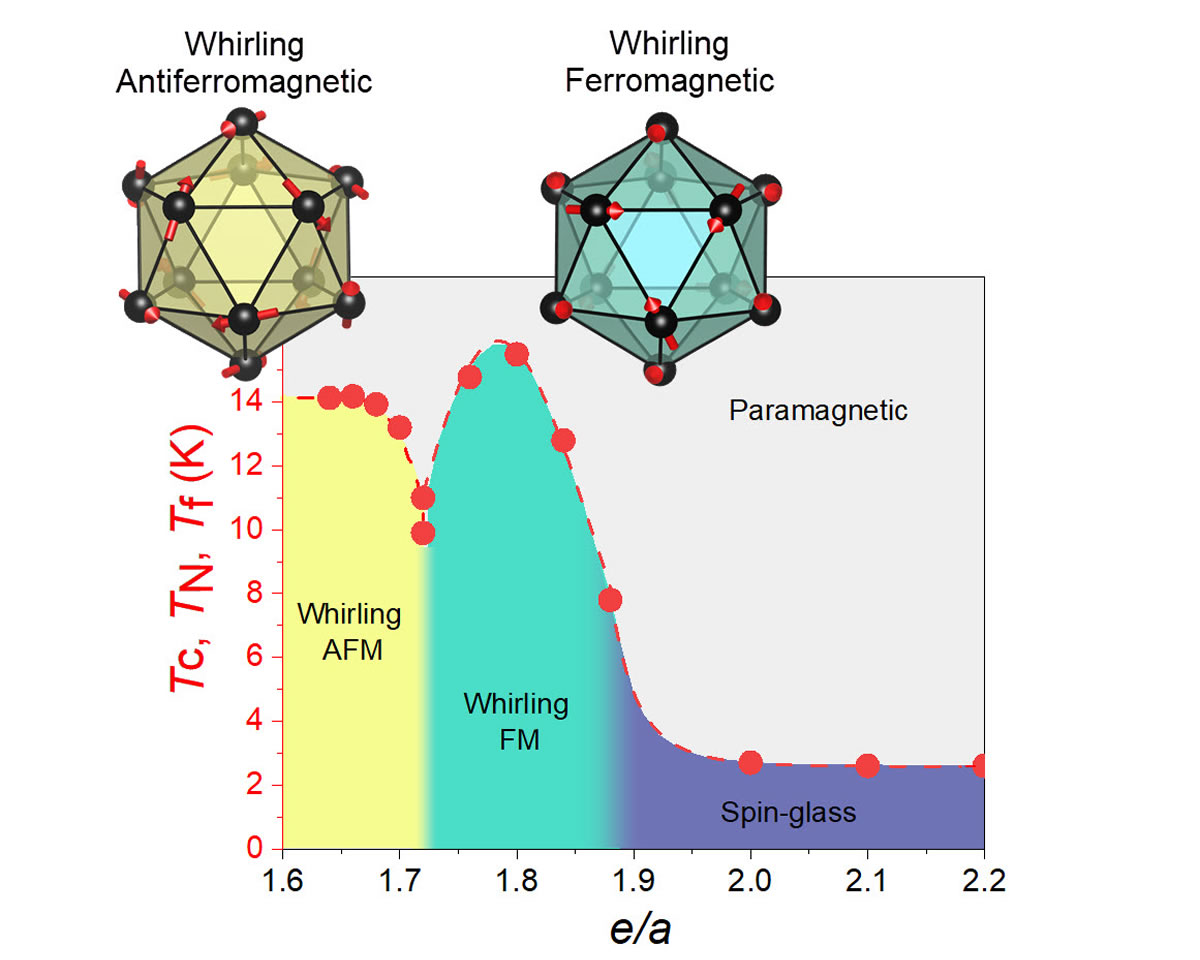Tokyo University of Science
Tohoku University
Researchers unveil the magnetic phase diagram of non-Heisenberg-type approximant crystals, for the first time, giving an impetus to applied research
Quasicrystals are intermetallic materials that have garnered significant attention from researchers aiming to advance condensed matter physics understanding. Unlike normal crystals, in which atoms are arranged in an ordered repeating pattern, quasicrystals have non-repeating ordered patterns of atoms. Their unique structure leads to many exotic and interesting properties, which are particularly useful for practical applications in spintronics and magnetic refrigeration.
A unique quasicrystal variant, known as the Tsai-type icosahedral quasicrystal (iQC) and their cubic approximant crystals (ACs), display intriguing characteristics. These include long-range ferromagnetic (FM) and anti-ferromagnetic (AFM) orders, as well as unconventional quantum critical phenomenon, to name a few. Through precise compositional adjustments, these materials can also exhibit intriguing features like aging, memory, and rejuvenation, making them suitable for the development of next-generation magnetic storage devices. Despite their potential, however, the magnetic phase diagram of these materials remains largely unexplored.
To uncover more, a team of researchers, led by Professor Ryuji Tamura from the Department of Materials Science and Technology at Tokyo University of Science (TUS) in collaboration with researchers from Tohoku University recently conducted magnetization and powder neutron diffraction (PND) experiments on the non-Heisenberg Tsai-type 1/1 gold-gallium-terbium AC.
“For the first time, the phase diagrams of the non-Heisenberg Tsai-type AC have been unravelled. This will boost applied physics research on magnetic refrigeration and spintronics,” remarks Professor Tamura.
Their findings were published in the journal Materials Today Physics on December 19, 2023.
Through several experiments, the researchers developed the first comprehensive magnetic phase diagram of the non-Heisenberg Tsai-type AC, covering a broad range of electron-per-atom (e/a) ratios (a parameter crucial for understanding the fundamental nature of QCs). Additionally, measurements using the powder neutron diffraction (PND) revealed the presence of a noncoplanar whirling AFM order at an e/a ratio of 1.72 and a noncoplanar whirling FM order at the e/a ratio of 1.80. The team further elucidated the ferromagnetic and anti-ferromagnetic phase selection rule of magnetic interactions by analyzing the relative orientation of magnetic moments between nearest-neighbour and next-nearest neighbour sites.
Professor Tamura adds that their findings open up new doors for the future of condensed matter physics. “These results offer important insights into the intricate interplay between magnetic interactions in non-Heisenberg Tsai-type ACs. They lay the foundation for understanding the intriguing properties of not only non-Heisenberg ACs but also non-Heisenberg iQCs that are yet to be discovered.”
In summary, the present breakthrough propels condensed matter physics and quasicrystal research into uncharted territories, paving the way for advanced electronic devices and next-generation refrigeration technologies!

Magnetic phase diagram of the systems uncovered in this study
A magnetic phase diagram of the Au-Ga-Tb 1/1 ACs showing e/a dependence of TC, TN, or Tf (red markers). The yellow, cyan, and dark blue background colours represent whirling AFM, whirling FM, and spin-glass regimes, respectively. The corresponding magnetic structures of the whirling AFM and FM orders are shown on top. ©Farid Labib (Tokyo University of Science)
Funding information
This work was supported by Japan Society for the Promotion of Science through Grants-in-Aid for Scientific Research (Grants No. JP19H05817, JP19H05818, JP19H05819, JP21H01044, JP22H00101, JP22H04582) and Japan Science and Technology agency, CREST, Japan, through a grant No. JPMJCR22O3. The experiments at JRR-3 were supported by the General User Program for Neutron Scattering Experiments (No. 22511), Institute for Solid State Physics, University of Tokyo and Sumitomo Foundation.
Publication Details:
“Unveiling exotic magnetic phase diagram of a non-Heisenberg quasicrystal approximant”
Farid Labib1, Kazuhiro Nawa2, Shintaro Suzuki3, Hung-Cheng Wu2, Asuka Ishikawa1, Kazuki Inagaki4, Takenori Fujii5, Katsuki Kinjo2, Taku J. Sato2, and Ryuji Tamura1
- Research Institute of Science and Technology, Tokyo University of Science
- Institute of Multidisciplinary Research for Advanced Materials (IMRAM), Tohoku University
- Department of Physical Science, Aoyama Gakuin University
- Department of Materials Science and Technology, Tokyo University of Science
- Cryogenic Research Center, The University of Tokyo
Materials Today Physics
DOI: 10.1016/j.mtphys.2023.101321
▶ Tokyo University of Science
▶ Tohoku Univeristy
▶ Quantum Spin Physics
Contact
Professor Ryuji Tamura
Department of Materials Science and Technology
Tokyo University of Science
Email: tamura[at]rs.tus.ac.jp
Associate Professor Kazuhiro Nawa
Institute of Multidisciplinary Research for Advanced Materials
Tohoku University
Email: knawa[at]tohoku.ac.jp
(Media contact)
Hiroshi Matsuda
Public Relations Division
Tokyo University of Science
Email: mediaoffice[at]admin.tus.ac.jp
Tohoku University, Public Relations
Email: public_relations[at]grp.tohoku.ac.jp